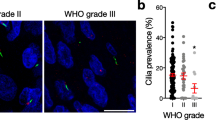Abstract
Patched (Ptc) is a transmembrane receptor for sonic hedgehog (Shh) and functionally associated with another transmembrane protein, smoothened (Smo). Ptc is a tumor suppressor gene whereas Smo serves as a proto-oncogene of neuroectodermal tumors. Their downstream molecules, Gli1, Gli2, and Gli3, are oncogenes of glioblastomas. We have analyzed mRNA expression of Ptc, Smo, and Gli family members in human astrocytic tumors. The mRNA expression was quantified by real-time polymerase chain reactions in 40 tumors (diffuse astrocytomas; 6 cases: anaplastic astrocytomas; 12 cases: glioblastomas; 22 cases) and four cell lines derived from astrocytic tumors. The MIB-1 proliferating cell indices (PCIs) of these tumors were analyzed by immunohistochemistry. In comparison with the World Health Organization (WHO) classification, the amount of Ptc and Smo mRNAs decreased in proportion to the progression of histological maliganancy, and similar results were obtained with astrocytic tumor-derived cell lines. However, there was no remarkable correlation between the mRNA expression level of each gene and the MIB-1 PCIs. The mRNA expression level of Gli1 was variable and highly elevated in two cases. No remarkable features were found clinically or histologically in these two cases.
In summary, our results indicate that Ptc and Smo mRNA levels have an inverse correlation with histological malignancy and suggest that these gene products are implicated in the suppression of astrocytic tumors. In contrast, there was no significant correlation between the mRNA levels of the Gli family members and histological malignancy, suggesting that Gli proteins are not associated with the progression of astrocytic tumors.
Similar content being viewed by others
References
Wechsler-Reya R, Scott MP: The developmental biology of brain tumors. Annu Rev Neurosci 24: 385–428, 2001
Lee J, Platt KA, Censullo P, Ruiz i Altaba A: Gli1 is a target of Sonic hedgehog that induces ventral neural tube development. Development 124: 2537–2552, 1997
Ingham PW, Taylor AM, Nakano Y: Role of the Drosophila patched gene in positional signalling. Nature 353: 184–187, 1991
Dai P, Akimaru H, Tanaka Y, Maekawa T, Nakafuku M, Ishii S: Sonic hedgehog-induced activation of the Gli1 promotor is mediated by GLI3. J Biol Chem 274: 8143–8152, 1999
Xie J, Johnson RL, Zhang X, Bare JW, Waldman FM, Cogen PH, Menon AG, Warren RS, Chen LC, Scott MP, Epstein EH Jr: Mutations of the PATCHED gene in several types of sporadic extracutaneous tumors. Cancer Res 57: 369–372, 1997
Xie J, Murone M, Luoh SM, Ryan A, Gu Q, Zhang C, Bonifas JM, Lam CW, Hynes M, Goddard A, Rosenthal A, Epstein EH Jr, de Sauvage FJ: Activating Smoothened mutations in sporadic basal-cell carcinoma. Nature 391: 90–92, 1998
Orenic TV, Slusarski DC, Kroll KL, Holmgren RA: Cloning and characterization of the segment polarity gene cubitus interruptus Dominant of Drosophila. Genes Dev 4: 1053–1067, 1990
Alexandre C, Jacinto A, Ingham PW: Transcriptional activation of hedgehog target genes in Drosophila is mediated directly by the cubitus interruptus protein, a member of the GLI family of zinc fingerDNA-binding proteins. Genes Dev 10: 2003–2013, 1996
Kinzler KW, Bigner SH, Bigner DD, Trent JM, Law ML, O'Brien SJ, Wong AJ, Vogelstein B: Identification of an amplified, highly expressed gene in a human glioma. Science 236: 70–73, 1987
Ruppert JM, Vogelstein B, Arheden K, Kinzler KW: GLI3 encodes a 190-kilodalton protein with multiple regions of GLI similarity. Mol Cell Biol 10: 5408–5415, 1990
Tanimura A, Dan S, Yoshida M: Cloning of novel isoforms of the human Gli2 oncogene and their activities to enhance tax-dependent transcription of the human T-cell leukemia virus type 1 genome. J Virol 72: 3958–3964, 1998
Ruppert JM, Kinzler KW, Wong AJ, Bigner SH, Kao FT, Law ML, Seuanez HN, O'Brien SJ, Vogelstein B: The GLI-Kruppel family of human genes. Mol Cell Biol 8: 3104–3113, 1988
Salgaller M, Pearl D, Stephens R: In situ hybridization with single-stranded RNA probes to demonstrate infrequently elevated gli mRNA and no increased ras mRNA levels in meningiomas and astrocytomas. Cancer Lett 57: 243–253, 1991
Kleihues P, Cavenee WK: Pathology and Genetics of Tumours of the Nervous System. International Agency for Research on Cancer, Lyon, 2000
Chomczynski P, Sacchi N: Single-step method of RNA isolation by acid guanidinium thiocyanate-phenol-chloroform extraction. Anal Biochem 162: 156–159, 1987
Gibson UE, Heid CA, Williams PM: Anovel method for real time quantitative RT-PCR. Genome Res 6: 995–1001, 1996
Heid CA, Stevens J, Livak KJ, Williams PM: Real time quantitative PCR. Genome Res 6: 986–994, 1996
Gerdes J, Becker MH, Key G, Cattoretti G: Immunohistological detection of tumour growth fraction (Ki-67 antigen) in formalin-fixed and routinely processed tissues. J Pathol 168: 85–86, 1992
Xiao H, Goldthwait DA, Mapstone T: A search for gli expression in tumors of the central nervous system. Pediatr Neurosurg 20: 178–182, 1994
Gorlin RJ: Nevoid basal-cell carcinoma syndrome. Medicine (Baltimore) 66: 98–113, 1987
Dahmane N, Lee J, Robins P, Heller P, Ruiz i Altaba A: Activation of the transcription factor Gli1 and the Sonic hedgehog signalling pathway in skin tumours. Nature 389: 876–881, 1997
Grachtchouk M, Mo R, Yu S, Zhang X, Sasaki H, Hui CC, Dlugosz AA: Basal cell carcinomas in mice overexpressing Gli2 in skin. Nat Genet 24: 216–217, 2000
Author information
Authors and Affiliations
Rights and permissions
About this article
Cite this article
Katayama, M., Yoshida, K., Ishimori, H. et al. Patched and Smoothened MRNA Expression in Human Astrocytic Tumors Inversely Correlates with Histological Malignancy. J Neurooncol 59, 107–115 (2002). https://doi.org/10.1023/A:1019660421216
Issue Date:
DOI: https://doi.org/10.1023/A:1019660421216




